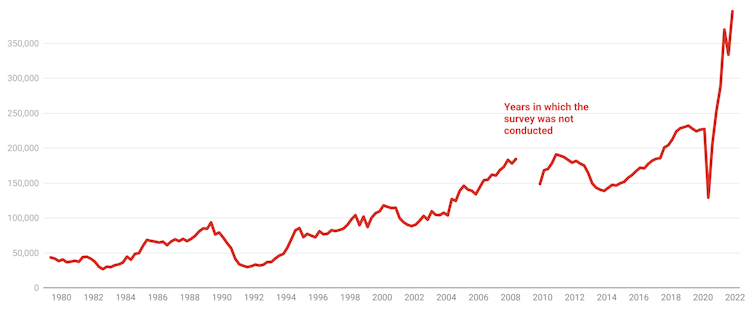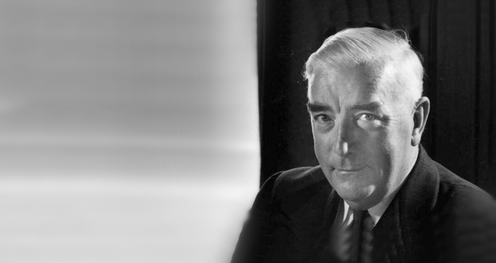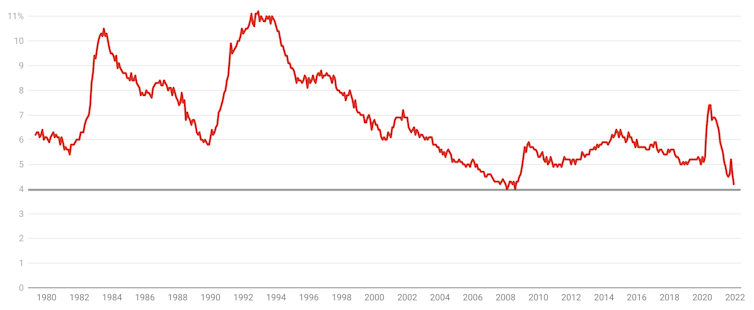What’s the boldest thing the Morrison government could do in next month’s budget?
It would be to forecast an unemployment rate below 4% (a rate of three-point-something), then to pledge to go further, to two-point-something.
Neither have happened for half a century; not since the long Coalition reign of Robert Menzies and his successors from the 1950s to the early 1970s, when unemployment was between 2 and 3%.
Astoundingly, both are now within Treasurer Josh Frydenberg’s reach in a way they weren’t mere weeks ago.
This time last year, the official budget strategy (its formal title is fiscal strategy) pledged to maintain economic support until the unemployment rate was “comfortably below 6%”.
Frydenberg ditched that target on the ground it was unambitious in the May budget, replacing it with a commitment to spend until the recovery was “secure and the unemployment rate is back to pre-crisis levels or lower”.
But – even projecting forward all the way out to 2025 – Frydenberg couldn’t promise an unemployment rate below 4%. There wasn’t the demand for workers to support it.
Suddenly, below 4% is possible
Even as late as December last year in the mid-year budget update, the best the treasury could forecast was an unemployment rate of 4.25%, which wouldn’t be reached until mid-2023 and wouldn’t be bettered in forecasts stretching out to mid-2025.
Then in January, we learnt that in December itself the unemployment rate had dipped below the forecast to 4.2% a year and a half early.
And it was the real thing. The unemployment rate hadn’t been cut artificially by people withdrawing from the search for work because of lockdowns (as had happened temporarily earlier in the year). Unemployment fell by 62,200 in December because an extra 64,800 people found work.
Unemployment touching 4%
Seasonally adjusted unemployment rate. ABS Labour Force
The proportion of the population aged 15 and over in work is the truest measure of employment, because it’s unaffected by whether or not someone calls themselves unemployed. In December last year, that had climbed to 63.3% – a record high.
Several countries, including Singapore, South Korea and New Zealand, do even better, suggesting we can push employment higher still.
And the jobs have come with hours. All but a few of the extra jobs created over the past year have been full-time. In December the total number of hours worked hit an all-time high. The proportion of workers underemployed (not getting the hours they want) sank to a record low.
The 50-year low is closer than it seems
The unemployment rate was better than it looked. Calculated to several decimal places rather than the usual single place, the December rate was 4.157% – within a hairsbreadth of the historic low of 3.981% achieved in February 2008 at the height of the mining boom; the only time in the modern era the rate slipped below 4%.
To get below 4% from here on, and to get below the previous long-term low, would only require an extra 25,000 people in jobs.
That’s what makes a budget forecast of an unemployment rate beginning with a “3” – the first since the 1970s – suddenly plausible. On Tuesday the prime minister said he expected it this year.
More vacancies than ever
Making something much better plausible – what until recently was a barely imaginable unemployment rate beginning with “2” – is the number of vacant jobs on offer.
In November, the Bureau of Statistics survey found a record 396,100 jobs on offer, so many as to mean one job for every 1.7 people looking. The more usual ratio, back in the days before COVID, was one vacancy for every three unemployed people looking.
More vacancies than ever

ABS job vacancies, seasonally adjusted
If half of those vacancies (198,000) were filled by someone presently unemployed, the unemployment rate would fall to 2.7%.
Which is another way of saying an unemployment rate lower than 3% – an unemployment rate beginning with “2” – is within reach.
A budget that forecast a rate lower than 4%, but adopted as a target or stretch forecast an unemployment rate lower than 3%, would make history.
It would have to set out the means to achieve it, one of which would be to adopt a new fiscal strategy that committed the government to “invest in a stronger economy” (the words in the existing fiscal strategy) until unemployment is between 2% and 3%.
What’s missing? A target and more help for job-seekers
The existing strategy commits the government to invest in a stronger economy until unemployment is down to “where it was prior to the pandemic or lower”.
The commitment would delay budget repair by only a few years, and it would make that repair quicker when it started because hundreds of thousands more Australians would be paying tax and no longer claiming JobSeeker.
And it would lock in an expectation of permanently lower unemployment, in the same way as the Reserve Bank’s success in crushing inflation in the 1990s locked in an expectation of permanently low inflation.
If the government articulated the target, the Reserve Bank would be likely to assist. Full employment is the second of the three goals spelled out in its charter.
The government would also have to do much more of what it started in its last budget, which is to set up programs to make unemployed workers more job-ready and make employers more likely to hire them.
Some of that is already happening as the large number of vacancies and low number of unemployed forces employers to take on people they wouldn’t have before. Many will be glad.
It’s within reach for Labor, or the Coalition
Often the only thing that’s “wrong” about a worker who has been out of work for a long time is that they have been out of work for a long time. As employers discover that, they are likely to find it is easier to fill vacancies than they thought.
An unemployment target of 2-3% would be game-changing, and it’s within reach. The last side of politics to preside over ultra-low unemployment was the Coalition, making it natural that Morrison and Frydenberg should take up the mantle of Robert Menzies and his treasurer Harold Holt.
If they won’t, it’s an opening for Labor. There’s a chance to all but eliminate unnecessary unemployment in Australia. Not in 50 years have we been this close.



 South Korea Extends Bond Market Stabilization Measures Amid Rising Financial Risks
South Korea Extends Bond Market Stabilization Measures Amid Rising Financial Risks  Asian Stocks Slide as AI Valuation Fears and BOJ Uncertainty Weigh on Markets
Asian Stocks Slide as AI Valuation Fears and BOJ Uncertainty Weigh on Markets  Wall Street Futures Slip as Tech Stocks Struggle Ahead of Key US Economic Data
Wall Street Futures Slip as Tech Stocks Struggle Ahead of Key US Economic Data  Oil Prices Slip in Asia as 2026 Supply Glut Fears and Russia-Ukraine Talks Weigh on Markets
Oil Prices Slip in Asia as 2026 Supply Glut Fears and Russia-Ukraine Talks Weigh on Markets  Korea Zinc Plans $6.78 Billion U.S. Smelter Investment With Government Partnership
Korea Zinc Plans $6.78 Billion U.S. Smelter Investment With Government Partnership  China’s November Economic Data Signals Slowing Industrial Output and Weak Consumer Demand
China’s November Economic Data Signals Slowing Industrial Output and Weak Consumer Demand  Japan Business Sentiment Hits Four-Year High, Boosting Expectations of BOJ Rate Hike
Japan Business Sentiment Hits Four-Year High, Boosting Expectations of BOJ Rate Hike  Gold Prices Slip Slightly in Asia as Silver Nears Record Highs on Dovish Fed Outlook
Gold Prices Slip Slightly in Asia as Silver Nears Record Highs on Dovish Fed Outlook  Asian Stocks Slide as Central Bank Decisions and Key Data Keep Investors Cautious
Asian Stocks Slide as Central Bank Decisions and Key Data Keep Investors Cautious  Bank of Korea Downplays Liquidity’s Role in Weak Won and Housing Price Surge
Bank of Korea Downplays Liquidity’s Role in Weak Won and Housing Price Surge  New Zealand Budget Outlook Shows Prolonged Deficits Despite Economic Recovery Hopes
New Zealand Budget Outlook Shows Prolonged Deficits Despite Economic Recovery Hopes  Fed Near Neutral Signals Caution Ahead, Shifting Focus to Fixed Income in 2026
Fed Near Neutral Signals Caution Ahead, Shifting Focus to Fixed Income in 2026  Japan PMI Data Signals Manufacturing Stabilization as Services Continue to Drive Growth
Japan PMI Data Signals Manufacturing Stabilization as Services Continue to Drive Growth  Asian Technology and Chipmaking Stocks Slide as AI Spending Concerns Shake Markets
Asian Technology and Chipmaking Stocks Slide as AI Spending Concerns Shake Markets  China’s Small Bank Consolidation Struggles as Profits Fall and Risks Persist
China’s Small Bank Consolidation Struggles as Profits Fall and Risks Persist 





























